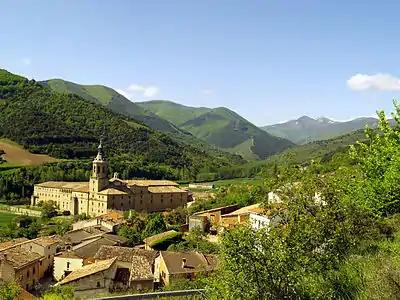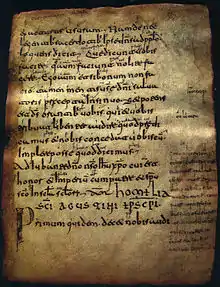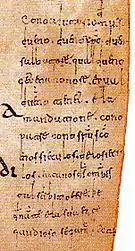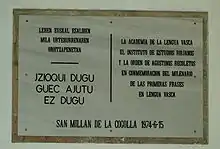Glosas Emilianenses
The Glosas Emilianenses (Spanish for "glosses of [the monastery of Saint] Millán/Emilianus") are glosses written in a Latin codex. These marginalia are important as early examples of writing in a form of Romance similar to Spanish, and in Basque. The anonymous author is assumed to have been a monk at the monastery now known as Suso ("the upper one"), one of the twin monasteries of San Millán de la Cogolla (now in La Rioja, then in the Kingdom of Navarre). He wrote about a thousand years ago in three languages:
- A simplified version of Latin
- The medieval form of a Hispanic Romance language (traditionally regarded as Castilian or Old Spanish, but now most often classified as Navarro-Aragonese or a related dialect);
- Medieval Basque

The latter two would have been the vernacular languages in the region surrounding the monastery, although there is a possibility that the author of the glosses was an incomer to the area.[1]

The Glosses were formerly considered to include the first instances of early Spanish. However, in November 2010, the Real Academia Española declared that the first appearances of written Spanish can be found in the Cartularies of Valpuesta, medieval documents in Latin from the province of Burgos.[2][3]
Location of the glosses
The codex is known as Aemilianensis 60 (Aemilianus is Latin for Emilian, "Millán" or "Emiliano" in modern Spanish) and was preserved in the monastery library at Yuso (the lower re-foundation of the monastery). Its significance was recognised in the early twentieth century when it was brought to the attention of the philologist Ramón Menéndez Pidal. The manuscript's current location is the Real Academia de la Historia in Madrid.
Romance glosses

There is still some debate as to whether the Iberian Romance language of the glosses should be classed as an early form of Castilian or of Aragonese, although some recent studies show that most features belong indeed to the latter.[4] It is not the only text to be difficult to classify: other texts traditionally assumed to be in Old Spanish, like the Kharjas, are proved to be in a different medieval Romance, Mozarabic, which happens to be classified along with Aragonese in a Pyrenean-Mozarabic group. Some scholars have proposed that it is anachronistic to classify such varieties of Ibero-Romance according to dialectal labels based on geographical particularism before the thirteenth century, leaving the Glosas to be understood as "in an unspecialized informal register of Ibero-Romance".[5]
However, should the Romance language of the glosses be classified, San Millán de la Cogolla's former reputation as the "birthplace of the Spanish language" was important in its designation as a World Heritage Site ("cultural" type) in 1997.[6]
Text and translation
The longest gloss appears on page 72 of the manuscripts. The Spanish philologist Dámaso Alonso called this little prayer the "first cry of the Spanish language" (in Spanish: "el primer vagido de la lengua española"[7]).
(Listen in restored pronunciation)

Old text
Con o aiutorio de nuestro
dueno Christo, dueno
salbatore, qual dueno
get ena honore et qual
duenno tienet ela
mandatione con o
patre con o spiritu sancto
en os sieculos de lo siecu
los. Facanos Deus Omnipotes
tal serbitio fere ke
denante ela sua face
gaudioso segamus. Amen.
Translation
With the help of our
Lord Christ, Lord
Savior, Lord
who is in honor,
Lord that has
command with
the Father, with the Holy Spirit
for ever and ever.
God Omnipotent, make us
do such a service that
before His face
joyful we are. Amen.
Comparative table
Comparison of some words used in the glosses, along with their current corresponding forms in Aragonese, Spanish and Latin language. English translation provided.
| Glosses | Aragonese | Spanish | Latin | Translation to English |
|---|---|---|---|---|
| de los (delo) | de los, d’os | de los | < DE ILLOS | of the (masculine, plural article) |
| ela | a, l’ | la | < ILLA | the (feminine, singular article) |
| ena, enos | en a, en os | en la, en los | < IN ILLAM, IN ILLOS | in the (feminine, singular and masculine, plural articles) |
| fere | fer | hacer[8] | < FACERE | to make |
| siéculo | sieglo | (sieglo >) siglo | < SAECULU | century |
| yet | ye | es | < EST | is (3rd person, singular, verb "to be") |
Basque glosses

Aemilianensis 60 has been publicized as the earliest known codex with inscriptions in Basque, though other codices are posited.
Only two of the glosses in Aemilianensis 60 (of a total of about one thousand) are actually in Basque.[9] These short texts (only 6 words in total) can be seen on the 1974 plaque. However, it has been suggested that some of the Romance glosses reflect the influence of the Basque language, the implication being that their author was a fluent Basque-speaker.
References
- The vernacular language in the region is now Spanish, but there are still some Basque place-names nearby, e.g. Ezcaray.
- Vergaz, M. (2010). "La RAE avala que Burgos acoge las primeras palabras escritas en castellano" (in Spanish). El Mundo
- "Académicos de la RAE tildan de "revolucionario" el estudio de los cartularios de Valpuesta" (in Spanish). Diario de Burgos
- (in Spanish) Las glosas emilianenses otra vez, H.J.Wolf, Revista de Filología Románica, nº 14, vol.I 1997, pp. 597-604. Servicio de Publicaciones, Universidad Complutense, Madrid.
- Roger Wright, A Sociophilological Study of Late Latin, 242.
- Entry on the World Heritage website
- (in Spanish) Primer vagido de la lengua española Dámaso Alonso (retrieved from www.espanolsinfronteras.com)
- In Old Spanish this verb also appears in the forms far, fer y fazer (facer).
- (in Spanish) Glosas en vascuence article by Juan Ángel Nieto Viguera on the Basque glosses
| Wikimedia Commons has media related to Glosas Emilianenses. |
| Wikisource has original text related to this article: |